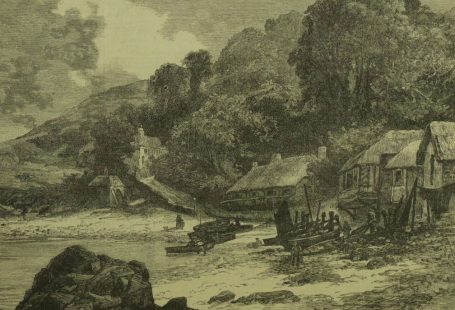During the month of September, The British Newspaper Archive is delving into stories of local history. We have had the pleasure of a guest blog by local Exeter historian David Cronforth and another blog demonstrating how to use The Archive for local history, as well as a webinar about using newspapers for local history research. To continue our theme, we are looking at local English culinary treats including the Yorkshire pudding, Staffordshire oatcake, Cornish pasty, eel pies of London’s East End and more. In the future, we will do similar blogs for Wales, Scotland, and Ireland.
Register now and view 3 pages for FREE
Yorkshire Pudding- Yorkshire
To begin our tour of local English foods, we searched for Yorkshire pudding, a staple of many Sunday dinners. The search gave us more than 14,000 results! We liked the look of the second article, ‘The Mysteries of the Yorkshire’. Would it reveal how to make the best pudding? It did provide steps for learning to make this dish: (1) Secure several generations of Yorkshire ancestors, (2) Get born in Yorkshire, and (3) At the age of twelve begin to imbibe the pudding traditions of the family. Not a great start, but then the article gave a detailed explanation about how to make a Yorkshire pudding. However, which is often the case in recipes from early newspapers, the author failed to give exact measurements.



On the same first page of results for Yorkshire pudding we found Lady Edith of the Belfast News-Letter with a recipe for Yorkshire pudding for 6 people. This is a clear example of The British Newspaper Archive’s ‘Golden Rule’.
Golden Rule
The Golden Rule of using newspapers for local history research is: do not limit yourself to your local papers when searching for a place or topic. News travelled, news of a locality could be recorded in another county or country. Many newspapers covered a large area as not every town had its own newspaper.

If we had limited our search to Yorkshire, we never would have found Lady Edith’s recipe. Along with recipes, we found this advertisement from an American woman requesting recipes for Yorkshire puddings. American GIs had been stationed in Yorkshire during the Second World War, and it seems they enjoyed the local fare. I wonder how many recipes Barbara of Washington received.

During our search we found a slight twist on the traditional Yorkshire pudding, ‘Apple Yorkshire Pudding’. Simply add stewed apples and sugar to the batter.
Cornish Pasty-Cornwall
After our Yorkshire puddings, we moved south for some Cornish pasties. In the 19th century, pastries were a low cost and convenient dish for the miners of Cornwall.

In our first search, we found a recipe from the Cornishman in 1880. It is a simple recipe without flair or additional ingredients besides the flour and fat for the pastry followed by meat and potatoes.
It did give us a helpful tip about how to eat our pasty, where ‘the seams are ended is sure to be the most meat or at least it is so in almost every case, for as the cook draws her paste together and fastens it the meat at on the top of the vegetables almost invariably shifts towards the end where the cook finished her joint’.

As we have noted in pervious Cookery Corners, advertisements are a great place to discover recipes. OXO cube gives us a full recipe for a Cornish pasty, of course it requires one OXO cube to give it the beefy flavour.
Cheese Straws- Suffolk
During initial research for this blog, we found that cheese straws originated in Suffolk, however, since then this has been hotly debated. The exact origin of the treat is unknown. Regardless, we thought it was such a tasty English treat that we decided to keep it in the blog.

Cheese straws appeared in the ‘Guinness Guide to Savouries’ in the Illustrated London News along with devils on horseback, scotch woodcock, eggs mimosa, and surprise tomatoes. The guide does not give us a full recipe, but we found the ingredients. This particular recipe called for Parmesan cheese.
Another recipe, found in the Brechin Advertiser, only mentions grated cheese as the ingredient but nothing specific. Across all the papers we found a consensus that cheese straws are a must if you are hosting a party. They are also great for an after-supper treat or midday snack.

The Lincolnshire Echo gives us another short recipe to follow. It asks for dry cheese, again not a specific type of cheese.

Scouse – Liverpool
Do you know why Liverpudlians or people of Liverpool are called Scousers? It is a slang term that originated in dietary habits. The name derives from the dish Lobscouse, or scouse for short, a type of stew popular with sailors, of which Liverpool had many as it was an important port city. We searched the newspapers to find recipes for this dish and discovered that it was composed of meat and potatoes and other vegetables. We also found it mentioned a few times as a traditional dish in the north on the Twelfth Night.


A Welsh correspondent wrote to the Liverpool Daily Post describing their version of scouse made with mutton, potatoes, onions, leeks, swedes, carrots, turnips, oatmeal, and water. The next week, a Liverpudlian correspondent was quick to explain that the Welsh dish was not the same as the northern scouse. In Liverpool they would not add oatmeal or leeks.


Kendal mint cake- Cumbria
The Kendal mint cake has been manufactured in Cumbria for more than 100 years. The peppermint treat found popularity among climbers as a source of energy. In The Archive we found repeated stories of people daring to climb Mount Everest and enjoying a mint cake at the summit.


Since Kendal mint cakes are a branded treat we weren’t able to find a specific recipe for it. We did come across one article talking about the history of the Kendal mint cake and it explained
‘The basic ingredients are always sugar, glucose, and mint, but most manufacturers add one or two other ingredients, the nature of which they keep to themselves’.
It continues to discuss the method, ‘It is not an easy sweetmeat to make, for the boiling has to be caught at exactly the right moment before the introduction of the mint’.

Oatcakes- Staffordshire
Staffordshire oatcakes, not to be confused with the Scottish oatcakes, are savoury pancakes and a favourite in north east England. We didn’t just find one recipe, but three in one article. The first recipe from Mrs F P of Rangemore added ginger and nuts, the second recipe from Mrs K C of Newton Street added currants and mixed spice, and the third formula from Mrs B of Walton-on-Trent used ginger, brown sugar, and treacle. Three variations of the same treat. Try all three and let us know which is best.

Jellied eels and eel pie – London
For our final local dish. we will take a close look, maybe not too close, at the eels of East London. Eels were easily sourced as they were one of the few fish able to survive in the polluted Thames. An initial search for eel pie did not give us recipes, but instead we find news and events of Eel Pie Island on the River Thames near Twickenham. Eel Pie Island was a popular holiday resort from the 1830s with the Eel Pie Island Hotel. In the 50s and 60s it became a hub of underground music, but in 1970 the hotel was forced to close its doors. The island was reinvented as the largest hippie commune in the UK. Today, the island is home to private residents.

Back to the pies! In order to remove Eel Pie Island from our results we used the advanced search option ‘exclude words’.
In one article from Taunton Courier, and Western Advertiser, we discovered how to make jellied, stewed, fried, and stuffed eels, as well as eel pies.


We came across a second eel pie recipe from Mrs Pepys diary. You may have read Mr Samuel Pepys’ 17th century diary, but this is Mrs Pepys’s Diary, a weekly causerie of feminine reflection found in The Falkirk Herald. In this article, Mrs Pepys revealed her husband’s Aunt Lettice’s special family recipe for an eel pie.
Remember to have plenty of salt nearby when handling the fish. ‘Slippery as an eel’ is not just an expression but a fact.
For more recipes from The British Newspaper Archive, check out our other Cookery Corner blogs.









1 comments On Cookery Corner – Local English Fare
The ideas are very interesting, and I totally agree with the author. I just want to add one more thing, the typography highly effects on users attention, IMO.
Thanks for sharing this article!